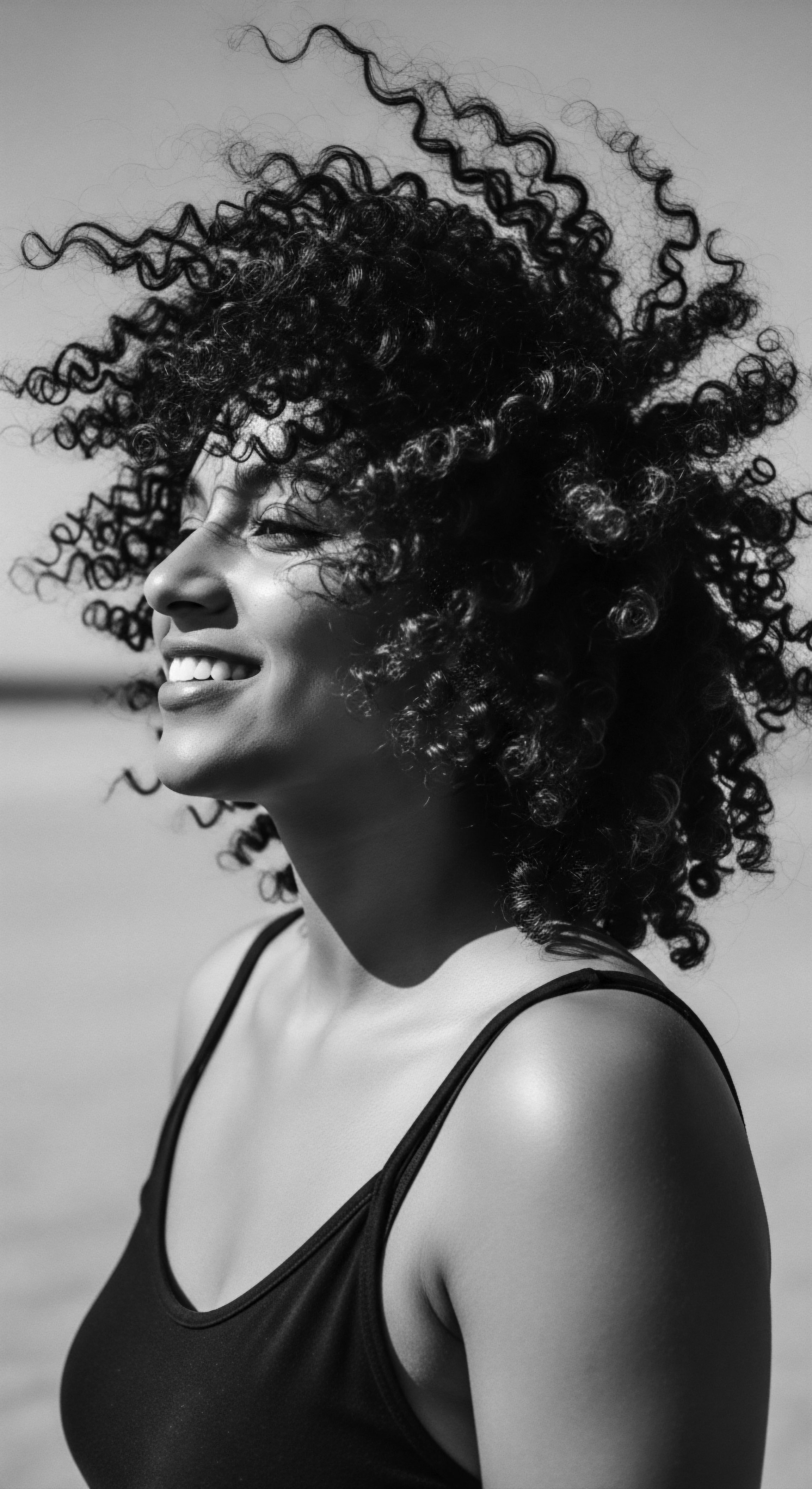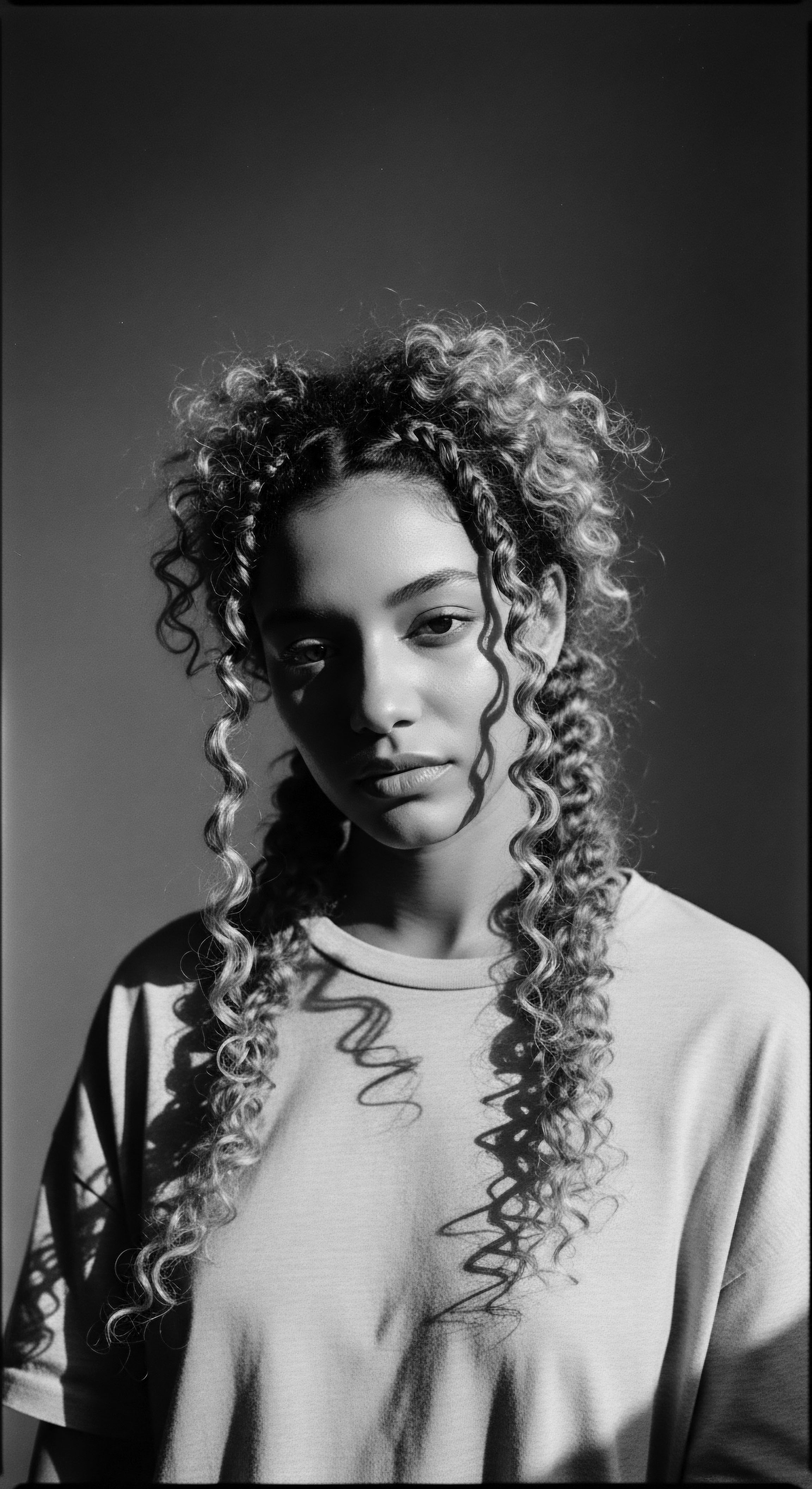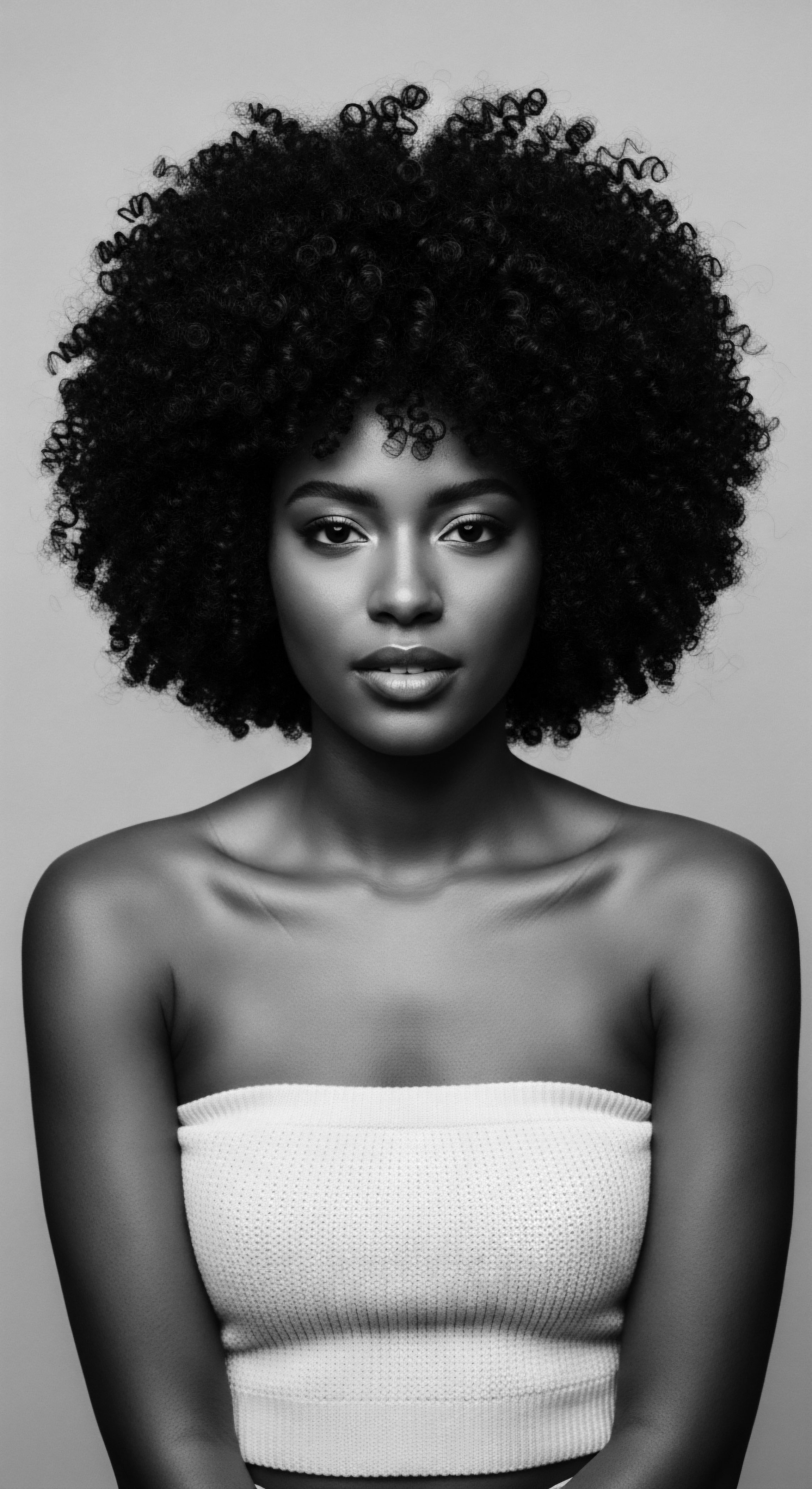The legacy of textured hair, with its coils and vibrant forms, speaks volumes of ancient wisdom and biological ingenuity. This intrinsic connection between our strands and the sun, a relationship forged over millennia on the vast sun-drenched plains of equatorial Africa, stands as a profound testament to the body’s capacity for adaptation. It is a story whispered through generations, a tale of survival, resilience, and the inherent brilliance embedded within our very being.

Roots
In the earliest dawn of humanity, as our ancestors stood upright beneath the powerful African sun, a remarkable transformation began. Their brains, growing larger and more complex, became particularly sensitive to heat. The body, stripped of much of its protective hair elsewhere, needed a new mechanism for cooling the head. The solution, an extraordinary stroke of natural design, arrived in the form of textured hair.
This hair, with its unique helical structure, did not merely adorn; it served as an ancient parasol, a living shield against the intense solar radiation. Researchers have found that tightly coiled hair significantly reduces the amount of solar heat reaching the scalp, minimizing the need to sweat and thus conserving precious water and electrolytes in arid environments (Lasisi et al. 2023). This physiological benefit, a passive cooling mechanism, allowed our ancestors to venture further under the midday sun, supporting the expansion of the human brain to its modern dimensions (Jablonski & Chaplin, 2014b).

Anatomy’s Ancient Purpose
The structure of textured hair, from its elliptical follicle to its characteristic coiling, is a biological marvel. This shape ensures that hair strands do not lie flat against the scalp, creating an air pocket, a buffer zone between the skin and the direct heat of the sun. This trapped air acts as a natural insulator, much like the layers in a well-built dwelling, limiting the absorption of heat. The spiral architecture disperses incoming solar radiation, rather than concentrating it, which prevents localized overheating and damage to the hair shaft itself.
This physical barrier provides effective protection against ultraviolet radiation, a primary concern in the high-UV environments where humanity first flourished. The presence of melanin, particularly eumelanin, in darker hair colors, also plays a crucial role. Eumelanin absorbs and dissipates UV light, offering inherent photoprotection for the hair fibers (Goddard, 2020). The darker the hair, the more robust this internal shield becomes, a fact observed across various populations.
The intrinsic coil of textured hair created an ancient, effective shield against the sun, safeguarding the evolving human brain.
Consider the contrast with straight hair, which, while offering some protection, tends to lie closer to the scalp, reducing the insulating air layer. The loft and volume inherent in textured hair — a direct consequence of its coiled morphology — ensure that more air is consistently trapped, enhancing its thermoregulatory capabilities. This evolutionary adaptation underscores a deep biological wisdom, where the very curl of a strand served a fundamental purpose for early human survival.

Hair’s Elemental Lexicon
Understanding textured hair involves recognizing its unique properties and the language that describes them, both scientifically and culturally. The coil pattern, often described using classification systems, speaks to the varying degrees of helix within each strand. However, beyond modern classifications, ancestral communities held their own understandings, often expressed through observation and lived experience of how hair responded to its environment. These understandings, passed down through generations, shaped early hair care practices.
The resilience of textured hair, its capacity to withstand intense solar exposure while facilitating cranial cooling, points to its powerful design. This enduring characteristic is a whisper from our earliest forebears, a deep connection to the lands where humanity first began its story.

Ritual
The profound wisdom of our ancestors, living in intimate harmony with the natural world, cultivated practices that intuitively aligned with hair’s inherent protective qualities. Long before scientific laboratories could dissect the physics of thermal regulation, communities across Africa developed intricate hair care and styling traditions that served as both cultural expression and practical defense against the sun’s unrelenting gaze. These ancestral practices were not merely about adornment; they were sophisticated forms of health preservation, embodying a deep understanding of the body’s needs in its environment.

Ancestral Designs for Sun Protection
Traditional African hairstyles often served as ingenious forms of protective styling, shielding the scalp and hair from direct solar radiation. Braids, twists, and cornrows, seen in ancient Egyptian drawings dating back to 2050 B.C. were more than aesthetic choices; they were methods to keep hair tucked away, reducing exposure to environmental stressors like the sun and heat (Ademefun, 2020).
These styles, some lasting for weeks, minimized manipulation and allowed the hair to retain moisture, crucial in arid climates. The density created by tightly intertwined strands offered a multi-layered canopy, an effective shade against the sun’s powerful rays, reducing the scalp’s thermal load.
Ancient African styling traditions were a profound fusion of cultural expression and sophisticated environmental adaptation.
For instance, the Himba tribe of Namibia employs a striking mixture known as Otjize, a paste of ochre and butterfat, applied to their hair and skin. This vibrant red coating holds significant cultural meaning, symbolizing connection to the land and ancestors. From a practical standpoint, this rich mixture provides protection from both sun and insects (Bebrų Kosmetika, 2024).
It speaks to an ancestral knowledge that utilized readily available natural resources for comprehensive well-being, where beauty and protection intertwined seamlessly. Similarly, in parts of West Africa, shea butter, rich in fatty acids and vitamins, has been used for centuries to protect hair from harsh sun and environmental damage, keeping it soft and hydrated (Conner, 2024).
The practice of hair wrapping with textiles, a custom still observed in many Black communities, also stands as a testament to this ancestral wisdom. African head wraps, with their diverse shapes and patterns, not only symbolize cultural richness but also serve to protect hair from sun damage and excessive heat. They offer a simple yet effective way to maintain healthy hair, allowing strands to air dry and retain moisture (Ademefun, 2020).

Care Rituals and Earth’s Bounty
The care of textured hair within ancestral communities was holistic, drawing directly from the earth’s bounty. The ingredients chosen for cleansing, conditioning, and strengthening hair were those proven effective over generations to protect against environmental challenges, including sun exposure. These practices highlight a deep respect for the hair as a living extension of the self and a link to heritage.
- Shea Butter ❉ Extracted from the nuts of the African shea tree, this butter is rich in vitamins and fatty acids. It provides deep moisture and creates a natural barrier against the sun’s rays.
- Coconut Oil ❉ Widely used across various tropical regions, coconut oil offers moisturizing properties and can help protect hair from protein loss, which can be exacerbated by sun exposure.
- Aloe Vera ❉ Valued for its soothing and moisturizing qualities, aloe vera gel was applied to both scalp and hair to alleviate sun irritation and promote overall hair health.
- Herbal Infusions ❉ Various local plants and herbs were brewed into rinses or mixed into pastes, providing natural conditioning, cleansing, and protective benefits tailored to regional climates.
These rituals, passed down through the ages, remind us that the intelligence required to care for textured hair in challenging environments existed long before modern science. It existed in the hands that braided, the communities that shared knowledge, and the earth that provided its gifts.
| Ancestral Practice Intricate Braiding and Coiling Styles |
| Region of Origin Across Sub-Saharan Africa |
| Sun Protection Mechanism Creates dense layers and a physical barrier against direct solar radiation, reducing scalp exposure. |
| Ancestral Practice Application of Otjize (Ochre and Butterfat Paste) |
| Region of Origin Himba Tribe, Namibia |
| Sun Protection Mechanism Forms a protective coating on hair and skin that shields from intense sun and elements. |
| Ancestral Practice Use of Shea Butter and Natural Oils |
| Region of Origin West Africa and other regions |
| Sun Protection Mechanism Nourishes and moisturizes hair, creating a natural barrier that helps mitigate sun-induced dryness. |
| Ancestral Practice These historical approaches exemplify the intertwined nature of hair care, cultural expression, and environmental adaptation. |

Relay
The insights garnered from the study of textured hair’s evolutionary journey offer a compelling narrative about human adaptation, particularly for those of Black and mixed-race experiences, where the heritage of textured hair is deeply intertwined with identity. This exploration transcends superficial beauty standards, rooting the discussion in fundamental biological and environmental pressures that shaped human populations. The findings, a convergence of anthropology and biophysics, illuminate how our hair’s structure provided a crucial advantage for survival, allowing for the cognitive advancements that define our species.

How Did Coiled Hair Facilitate Brain Growth?
As early hominins transitioned to bipedalism in equatorial Africa, their scalps became increasingly exposed to direct solar radiation. The brain, a metabolically active organ, generates considerable heat. Unchecked solar heat influx, combined with internally generated heat, posed a significant risk of overheating, potentially leading to heat stroke and impairing brain function. While the body developed efficient sweat glands to cool down, sweating involves a costly loss of water and electrolytes, a resource often scarce in these environments (Lasisi et al.
2023). Here, the evolutionary brilliance of tightly coiled hair becomes evident.
A landmark study published in the Proceedings of the National Academy of Sciences in 2023 by Lasisi, Smallcombe, Kenney, and Jablonski demonstrated through thermal manikin experiments that tightly curled hair provides superior protection against the sun’s radiative heat compared to straight or moderately curled hair (Lasisi et al. 2023). This protective effect is due to the inherent loft and air pockets within the coiled structure, which create a passive insulation layer. This layer effectively reduces the solar heat gain to the scalp, thus minimizing the need for evaporative cooling via sweating.
By reducing the physiological cost of thermoregulation, the body could allocate more resources to the energetically demanding process of brain development and function. This suggests that coiled scalp hair was not merely an aesthetic outcome; it was a biological imperative that supported the remarkable expansion of human cranial capacity, a testament to the intricate relationship between environment, biology, and the course of human evolution.

What Role Does Melanin Play in Hair’s Sun Defense?
Beyond the structural advantages of coiling, the melanin content within textured hair provides an additional layer of defense against solar radiation. Melanin, the pigment responsible for hair color, exists primarily in two forms ❉ eumelanin (dark brown to black) and pheomelanin (red and yellow tones). Hair rich in eumelanin, characteristic of darker hair types, exhibits greater photoprotective properties (Goddard, 2020).
Eumelanin’s capacity to absorb and dissipate ultraviolet (UV) light is significant. It acts as an internal shield, neutralizing reactive oxygen species that form upon UV exposure, thereby protecting the hair’s protein structure from degradation and preventing damage like dryness and brittleness (LearnSkin, 2020).
This biological mechanism means that darker textured hair, often abundant in eumelanin, is inherently more resistant to the damaging effects of UV rays. This inherent protective quality is a powerful echo of the ancestral environments where humanity originated, where intense solar radiation necessitated robust defenses for both skin and hair. The synergy between the coiled structure of textured hair and its rich melanin content provides a dual protective system, an elegant solution to the environmental challenges of our earliest hominin ancestors. This deep connection between hair texture, pigment, and environmental adaptation is a profound part of the heritage of Black and mixed-race peoples, a living narrative of survival and strength.
The understanding of this evolutionary heritage reframes conversations around textured hair, moving beyond superficial aesthetics to a scientific appreciation of its unique capabilities. It underscores the importance of honoring and understanding textured hair not as a variation but as a highly adapted form, perfectly calibrated for its ancestral environment.

Reflection
The journey through the evolutionary advantages of textured hair against the sun reveals more than biological facts; it uncovers a deep, abiding connection to our shared human story, particularly for those whose lineage carries the legacy of coiled strands. Our hair, a living archive, whispers tales of scorching savannas, ingenious adaptations, and the sheer tenacity of life. It speaks of a time when every curl, every coil, was a silent guardian, a meticulously crafted shield against the relentless glare of the sun, directly supporting the flourishing of our minds. This is the very Soul of a Strand, a profound narrative of heritage woven into the very fabric of our being.
To grasp the wisdom held within textured hair is to honor a legacy of resilience and natural brilliance. It is to recognize that the unique structures, so often misunderstood or undervalued in contemporary society, represent an ancient triumph of adaptation. Each strand carries echoes from the source, from the very cradle of humanity, reminding us that beauty and function were, from the beginning, inextricably linked. Understanding this deep heritage allows us to see textured hair not as something to be “managed” or “changed,” but as a sacred inheritance, a testament to ancestral ingenuity and survival.
It calls upon us to listen to the tender thread of tradition, to value the rituals of care that nurtured these strands through generations, and to carry forward this profound appreciation. This knowledge truly shapes our futures, informing how we voice identity and embrace the unbound helix of our heritage, celebrating the enduring strength written into every curl.

References
- Ademefun, S. (2020). A Brief History Of Black Hair Rituals. ELLE.
- Bebrų Kosmetika. (2024). The Power of Hair in African Folklore ❉ Rituals and Traditions. Bebrų Kosmetika.
- Goddard, N. (2020). Melanin for Hair ❉ What Role It Plays & How to Increase Production. Healthline.
- Jablonski, N. G. & Chaplin, G. (2014b). The Evolution of Skin Pigmentation and Hair Texture in People of African Ancestry. Dermatologic Clinics, 32(2), 113–121.
- Lasisi, T. Smallcombe, J. W. Kenney, W. L. & Jablonski, N. G. (2023). Human scalp hair as a thermoregulatory adaptation. Proceedings of the National Academy of Sciences, 120(24), e2301760120.
- LearnSkin. (2020). Photo Protection for Hair ❉ Protect Your Hair From UV Sunlight. LearnSkin.
- Conner, P. (2024). Hair Care Secrets of the Past ❉ What Our Ancestors Used for Healthy Hair.
